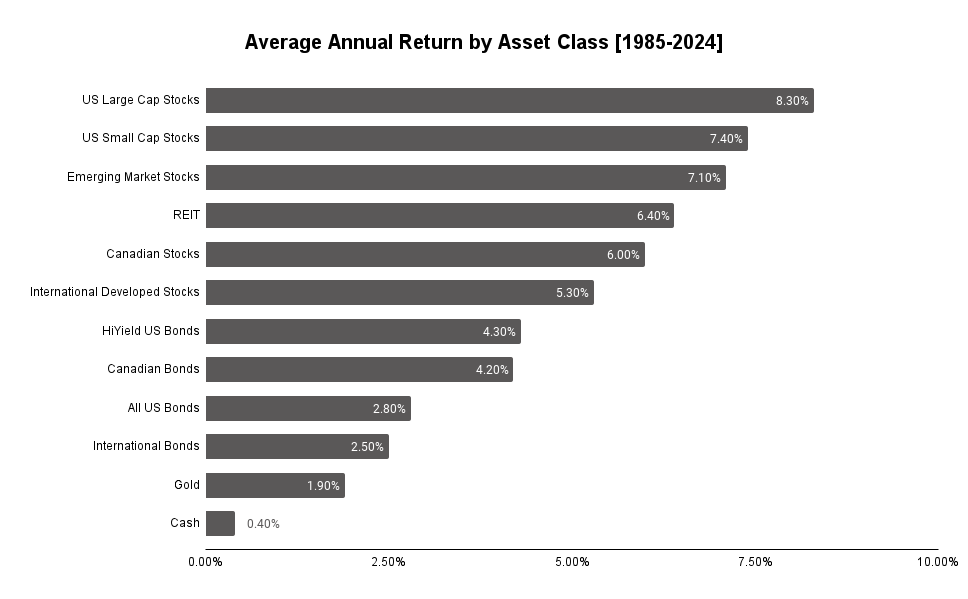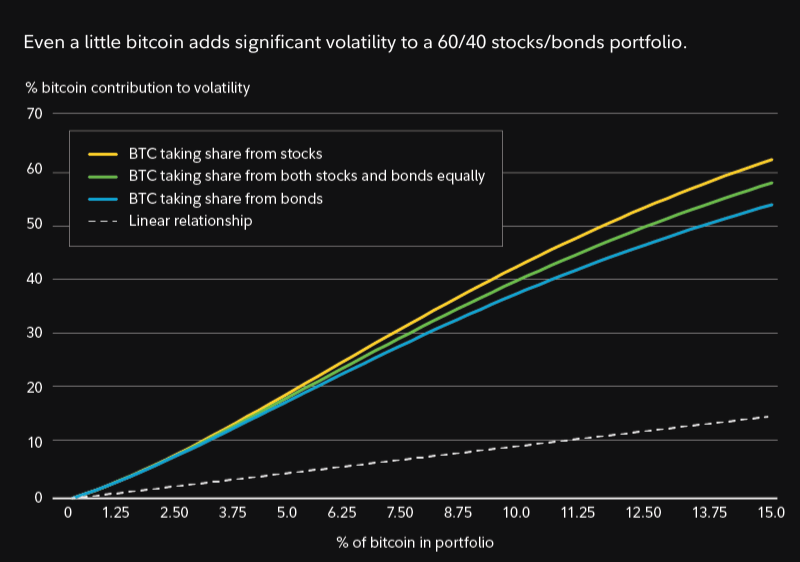
Crypto assets have quite rightly become a must in every investor’s portfolio in recent years, and as it matures as an asset class, more investors are considering its role within a diversified portfolio.
Determining how much of your portfolio to allocate to Bitcoin (BTC) is a critical decision that depends on your financial goals, risk tolerance, and investment horizon.
Here’s a look at how you might approach this decision, supported by industry research and expert opinions.
The Case for Bitcoin in a Portfolio
Bitcoin has been touted for its potential to enhance portfolio diversification due to its low correlation with traditional asset classes like stocks and bonds. It truly stands as its own asset class with performance and returns, unlike any other assets in the current market.
Historically, Bitcoin has provided exceptionally high returns, albeit with significant volatility. Its annual return over the past ten years looks something like this:

As of July 2024, bitcoin has seen a compounded annual growth rate (CAGR) of +56.36% in the last ten years. And a whopping +144.14% CAGR since its birth in 2009, making it the best-performing asset in the market, despite its volatility.
When looking at traditional asset classes, the CAGR for the best-performing asset is at a mere +8.3%, over the whole period of 1985 to 2024, the best asset classes are:
- U.S. large-cap stocks: +8.3% per year (annualized real total return)
- U.S. small-cap stocks: +7.4% per year
- Emerging market stocks: +7.1% per year

Adding Bitcoin to a well-balanced portfolio could significantly enhance your total asset value, especially if the investment is geared toward a long-term strategy.
Optimal Allocation: Industry Recommendations
There has been a lot of debate among traditional industry experts and how much asset allocation should belong to bitcoin. But as Bitcoin keeps on progressing and defying the expectations of even the most adored thought leaders, the answer to a definite number is and most likely will always be varied.
Fidelity
According to research by Fidelity, adding Bitcoin to a traditional 60/40 portfolio (60% equities, 40% bonds) can enhance diversification. However, due to Bitcoin’s extreme volatility, even a small allocation can significantly impact the portfolio’s risk and return profile.

Fidelity’s analysis suggests that a 3% allocation to Bitcoin could require it to deliver an average annual real return of 15.5% to justify the inclusion without altering the portfolio’s risk level dramatically.
For a more aggressive 80/20 portfolio, the required return drops to 10.3% per year, while a more conservative 40/60 portfolio would need Bitcoin to return 30.2% per year to justify a similar allocation.
MacroHive
Macro Hive’s research indicates that a 3% allocation to crypto (including Bitcoin) could significantly improve a portfolio’s risk-adjusted returns. Their study demonstrated that a portfolio with a 3% crypto allocation had a 75% higher Sharpe ratio, an 81% higher Sortino ratio, and a 79% higher Calmar ratio compared to a portfolio without crypto. This implies better performance on a risk-adjusted basis, meaning the portfolio can potentially offer higher returns with a manageable increase in volatility.
Greyscale
Grayscale recommends that investors consider allocating around 5% of their portfolio to cryptocurrencies, as this could enhance risk-adjusted returns for those with a balanced mix of stocks and bonds. However, it’s important to note that including crypto will likely increase overall portfolio risk.
According to Greyscale, cryptocurrencies can play a valuable role in constructing a well-rounded portfolio. Bitcoin and other digital assets have historically delivered high returns, albeit with high risk, and have shown a low correlation with public equities. This unique combination suggests that they have the potential to boost portfolio returns while also contributing to diversification.
ArkInvest
Ark Invest suggests that the optimal Bitcoin portfolio allocation might actually be closer to 19.4%. A big increase from the earlier year period, when the optimal allocation was standing at 6.2%, and 4.8% the year before that.
In the report published by Ark Invest, Big Ideas 2024, the investment firm provides a detailed analysis of how it came to this figure, pointing out bitcoin’s high CAGR compared to traditional assets.
Balancing Risk and Reward
The truth is there is no one-shoe-fit approach when it comes to investment. Every investment has different goals, but a few things to consider before investing in crypto or any asset are:
- The asset itself
- Historial performance
- Risk tolerance
- Investment time horizon
- Exit strategy
- Tax implications
- Market sentiment
All of these factors play a role in making an informed decision on whether to invest in an asset.
While industry experts suggest a conservative approach of 5% asset allocation in bitcoin, a figure primarily stemming from bitcoin’s high volatility rate, there are extreme cases where individual investors have allocated as high as 80% of their assets in crypto (bitcoin and altcoin including).
While such a high percentage might be an extremely risky move and not the best investment strategy, these investors are usually Bitcoin maxis who believe that ‘Bitcoin is King.’
When it comes to investment, the best strategy is and has always been to diversify. A diverse portfolio is a healthy portfolio.
It’s also important to note that rebalancing plays a crucial role in managing Bitcoin’s allocation in your portfolio. As the value of Bitcoin fluctuates, it’s essential to periodically adjust your holdings to ensure that Bitcoin does not unintentionally become an oversized portion of your portfolio due to price increases.
Bitcoin’s Role in Hedging and Inflation Protection
Some investors view Bitcoin as a hedge against inflation, given its fixed supply and decentralized nature. While it has shown potential, Bitcoin’s correlation with inflation and other macroeconomic factors remains inconsistent.
Therefore, while it may serve as a partial hedge, relying solely on Bitcoin for inflation protection could be premature.
Conclusion: Tailoring Allocation to Your Needs
In summary, the appropriate allocation of Bitcoin in your portfolio should reflect your investment goals, risk appetite, and market outlook. Experts generally recommend a small allocation of 1% to 5% to balance the potential for high returns with the risk of volatility.
As with any investment decision, it is crucial to stay informed, consider your long-term financial objectives, and consult with a financial advisor to ensure that your Bitcoin allocation aligns with your overall investment strategy.
Given the rapidly evolving nature of cryptocurrency markets, keeping abreast of the latest research and market developments will also help you make informed decisions about Bitcoin’s role in your portfolio.
Disclaimer: This article is not investment advice but is meant for information purposes only. Please perform your own due diligence and consult a financial advisor before making any financial decisions.
How Much Of Your Portfolio Should You Allocate To Bitcoin? was originally published in The Dark Side on Medium, where people are continuing the conversation by highlighting and responding to this story.
from The Dark Side - Medium https://ift.tt/FWkg8Sy
0 Comments